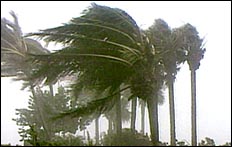|

Wind is often defined as the horizontal movement of air relative to the earth's surface. All winds, from gentle breezes to
raging hurricanes, are caused by differences in the temperature of the atmosphere, by rotation of the Earth, and by unequal
heating of the continents and the oceans. The sun heats the earth's surfaces unevenly. Air above hot areas expands and rises.
Air from cooler areas then flows in to replace the heated air. This process is called circulation.
There are three types of wind circulation. Circulation over the entire earth is the general circulation. Smaller-scale
circulations that cause day-to-day wind changes are known as synoptic-scale circulations. Winds that occur only in one place
are called local wind
|
 |

Pressure differences tend to push winds in straight paths. Yet winds follow curved paths across the Earth. In 1835, Gustave-Gaspard
Coriolis, a French scientist, first described mathematically what's going on, giving his name to the Coriolis force.
In simple terms, as air begins flowing from high to low pressure, the Earth rotates under it, making the wind follow a
curved path. In the Northern Hemisphere, the wind turns to the right of its direction of motion. In the Southern Hemisphere,
it turns to the left. The Coriolis force is zero at the equator
|

